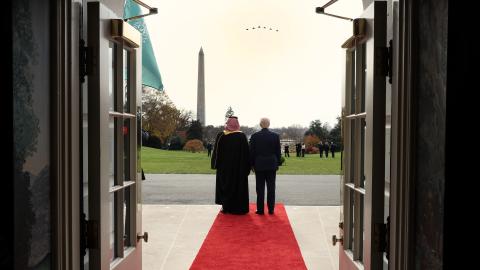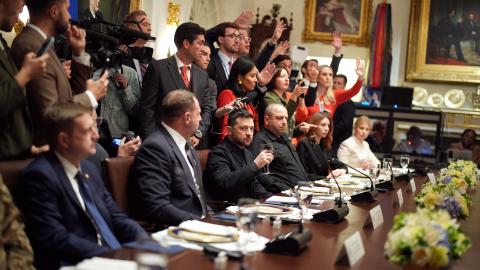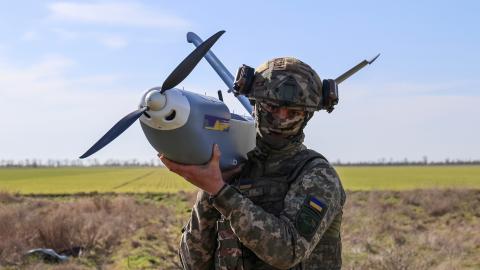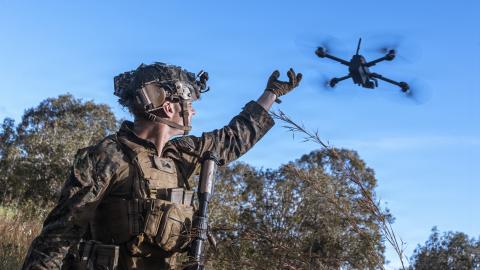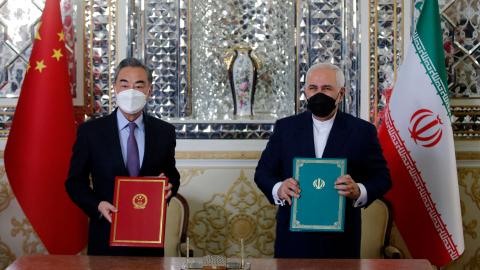Israel’s Operation Rising Lion unleashed a ferocious assault, swiftly dismantling Iran’s warfighting infrastructure. Precision strikes eliminated senior commanders of the Islamic Revolutionary Guard Corps (IRGC), destroyed missile- and drone-production hubs, and severed Tehran’s command networks. Within days, President Donald Trump seized the moment and launched Operation Midnight Hammer, ordering U.S. strikes on Iran’s nuclear strongholds at Fordow, Natanz, and Isfahan. These sites formed the backbone of Tehran’s nuclear ambitions, and they were hit with surgical precision at a moment of maximum vulnerability.
The campaign has advanced with speed and strategic focus, building on Israel’s sustained effort to dismantle Iran’s regional influence, from crippling Hizballah in Lebanon, to eliminating the Hamas politburo chief Ismail Haniyeh in Tehran, and targeting Houthi positions in Yemen. But the war is about more than battlefield gains. Washington and Jerusalem have undermined Iran’s place in the Middle East, and by doing so have destabilized the anti-American axis—led by China and Russia—of which it is a part.
Since 1979, the Islamic Republic of Iran has cast itself as the vanguard of global resistance to Western dominance. Its revolutionary ideology fuses Shiite political theology with a militant, anti-Western breed of anti-imperialism, portraying the United States and Israel not simply as geopolitical adversaries, but as existential enemies of a divinely ordained order. The Islamic Republic’s founder, Ayatollah Ruhollah Khomeini, encapsulated this worldview by framing of America as the “Great Satan” and Israel as the “Little Satan,” and making “Death to America” his regime’s enduring slogan.
This ideology, of necessity, does not stop at Iran’s borders—or even at the boundaries of the Middle East. From its founding, the Islamic regime has viewed Iran as the surrogate of a broader revolution, a vessel for exporting its model of “resistance,” which is its preferred term for the struggle against the West. It has advanced this mission through networks of armed proxies in the Middle East, and of religious seminaries across the globe. By casting resistance as a moral imperative, the Islamic Republic offers an ideological blueprint that binds together a diverse array of actors, from Shiite militias in Iraq, to guerrillas in Africa, to money-laundering networks in Latin America, all under the banner of anti-Americanism.
For China and Russia, this narrative of a sacred struggle against the West offers a moral framework for challenging the U.S.-led order—making Iran not just a strategic ally, but an ideological force within the axis. Thus in 2023 Xi Jinping attacked Western sanctions on Iran over its nuclear program by declaring that “China supports Iran in safeguarding national sovereignty and resisting unilateralism and bullying.” Xi’s phrasing put in secular terms, consistent with China’s own official messaging, the ayatollahs’ doctrine of resistance.
Aside from its ideological utility, Iran plays three major converging geostrategic roles in the Russia-China axis. First, it destabilized the Middle East through a sprawling proxy network in Lebanon, Syria, Iraq, and Yemen—consisting of armed movements designed to encircle Israel, weaken American allies, and shift the regional balance through relentless asymmetric warfare.
Second, it served as a critical strategic asset to Moscow and Beijing by facilitating sanctions evasion and anchoring diplomatic coalitions aimed at eroding the U.S.-led order.
Third, it offered geographic and logistical depth to the axis, acting as a bridge between Eurasia and the Middle East, and enabling Russia and China to expand their influence across energy corridors and strategic chokepoints. For Beijing, this positioning was vital to its infrastructure push across southern Asia, known as the Belt and Road initiative. For Moscow, it offered a rear base of operations for military and paramilitary coordination.
It is precisely this role that Israel and the United States have now targeted. Through a coordinated military campaign, Washington and Jerusalem are systematically dismantling the infrastructure that enabled Iran to facilitate covert arms transfers and support proxy networks. Key channels of Iran’s clandestine exports and regional influence, vital to both Moscow and Beijing, are now under serious threat.
Even more consequentially, the campaign shattered Iran’s long-cultivated myth of divine protection that has underpinned its symbolic value to its great-power allies. With that image broken, its reliability as a partner in an anti-U.S. axis is now in question.
Following Israel’s strikes, the fallout was swift. In a 50-minute call with President Trump following Israel’s strikes, Vladimir Putin condemned the operation and urged de-escalation, signaling Moscow’s deep concern. The Kremlin aide Yuri Ushakov later warned of the “risks of escalation,” reflecting fears that Iran’s unraveling could erode Russia’s regional influence. For Beijing, the stakes are no less severe: Iran’s logistical networks and sanctions-resistant systems—now under threat—are critical enablers of China’s ambitions across the Middle East and Africa.
Just as revealing was the silence that followed Washington’s strikes on Tehran’s key nuclear facilities. When Iran came under direct attack, neither Xi Jinping nor Vladimir Putin offered support. While Iran’s supreme leader Ali Khamenei was under siege, both remained publicly disengaged, probably not out of indifference, but out of alarm. Then, just days after the strikes, on June 19, Putin and Xi held a phone call, not to address the crisis in Iran, but to discuss expanding economic ties and strengthening coordination at the UN and through the Shanghai Cooperation Organization and BRICS, two international institutions created to provide an alternative to those led by the U.S. Their focus, pointedly, was on protecting and advancing their own agenda, not on coming to Tehran’s defense.
The myth of Iran’s strategic resilience has collapsed, and with it, the credibility of China and Russia’s bet on Tehran as a durable pillar of their anti-American front. Putin and Xi were happy to aid Iran when it was scoring strategic victories, but they have no interest in taking risks to support it when its stock is plummeting. But before looking more closely at these two powers’ reactions, its first worth considering in more detail what exactly Iran offers them.
The View from Beijing
Iran is central to China’s Middle East strategy, not simply as a regional partner but as a strategic asset through which Beijing can challenge U.S. dominance. By deepening ties with Tehran, China establishes a presence in one of the most conflict-ridden areas of the world while avoiding the risks and costs of military entanglement. This approach gives China access to energy resources, port infrastructure, and intelligence-sharing opportunities that would otherwise be extremely difficult to obtain. Iran’s entrenched hostility to the United States and its isolation from the Western financial system make it uniquely suited to host Chinese economic and security initiatives under conditions that shield both parties from external scrutiny.
This alignment reflects a broader Chinese strategy rooted in Mao Zedong’s theory of protracted war. Mao argued that when confronting a more powerful adversary, the path to victory lies not in open conflict but in sustained, patient erosion through encirclement, indirect pressure, and selective escalation. Xi Jinping has adapted this logic to the modern geopolitical environment in the Middle East, using Iran as part of a global network of partnerships that gradually weaken U.S. influence through asymmetric competition. Rather than overtly provoking Washington, Beijing leverages its relationship with Tehran to expand its footprint in the region, disrupt existing alliances, and insert itself into conflicts where it can act as a counterweight to American leadership.
One pillar of this partnership is energy. Iranian oil underpins the China–Iran relationship, providing Beijing with both economic leverage and strategic insulation. Through a system of sanctions-evasion networks and third-party intermediaries, China purchases Iranian crude oil at steep discounts below global market prices. These transactions are deliberately structured to avoid detection by U.S. financial monitors, often routed through opaque shipping arrangements and shell companies operating in jurisdictions with weak enforcement. This illicit energy trade serves multiple Chinese objectives. First, it allows Beijing to build up its strategic petroleum reserves quietly without exposing itself to price volatility or diplomatic backlash. By stockpiling cut-rate Iranian oil outside the traditional market, China reduces its vulnerability to supply shocks, embargoes, or coordinated Western pressure.
Second, it limits China’s dependence on U.S.-aligned producers in the Persian Gulf. Countries like the United Arab Emirates, Saudi Arabia, and Kuwait remain embedded in the American alliance system. In a crisis scenario—whether in the Taiwan Strait or the South China Sea—China cannot assume these producers would be politically neutral. Iran, however, is likely to remain a loyal supplier to China and unlikely to buckle under U.S. pressure.
Third, Iranian oil serves as a hedge against China’s geographic constraints. Roughly 80 percent of China’s crude imports pass through maritime chokepoints like the Strait of Malacca, which is patrolled by U.S. and allied naval forces. In the event of a military conflict or blockade, Beijing’s access to energy could be severed within days. Iranian oil reaches China through covert maritime shipments, often using unregistered vessels—creating a parallel supply chain that is harder to disrupt.
In this context, Iranian oil is a strategic asset. It feeds China’s industrial machine, supports its energy independence, and insulates it from the coercive power of the U.S.-led global order. That is why Israeli strikes on Iran pose such a significant threat to Beijing: they do not just degrade the military capacity of an ally; they also jeopardize the energy architecture that China has spent years building in order to secure its path to superpower status.
Beyond energy, Iran is a key partner in China’s Belt and Road Initiative, which seeks to create a network of overland routes, ports, and railroads stretching from China and southeast Asia westward across the continent, through the Middle East, and onward to Europe and even Africa. This massive infrastructure undertaking is mainly controlled by Beijing, and of course comes with Chinese conditions. Iran’s geography positions it as a crucial hub in this system—or, better, the location of many crucial hubs. The 25-year China–Iran strategic partnership, concluded in 2021, cemented this role and transformed Iran into a critical artery in Beijing’s vision of a new Eurasia, one where Chinese power provides a counterweight to U.S. dominance.
Iran’s military activities, especially the war being waged on global shipping by its Houthi proxies in Yemen, also serve China’s purposes by tying down U.S. military resources, unsettling American allies, and exacting an economic cost. To this end, Beijing, using deniable channels, helps the Houthis target Western ships and keeps other Iran-backed groups afloat indirectly by buying Iranian oil. This low-cost strategy allows China to reap the benefits of low-grade warfare without risking direct conflict.
China’s cooperation with Iran has also yielded significant diplomatic dividends, allowing Beijing to expand its influence in the Middle East beyond the purely economic domain. The centerpiece of this strategy was China’s facilitation of the Saudi-Iran normalization agreement, a diplomatic breakthrough that effectively neutralized Riyadh’s historic opposition to Tehran’s regional projects and ambitions while taking it a step away from the U.S. (and Israel).
Similarly, China leveraged its ties with Iran to support the April 2024 reconciliation agreement between Fatah and Hamas. Although the agreement is as sturdy as tissue paper, it complicates U.S.-backed peace frameworks, enabling Mahmoud Abbas’s Fatah party to thumb its nose at Western efforts to isolate Hamas and possibly replace it with the Palestinian Authority in Gaza. Together, these diplomatic achievements enhance China’s standing as an indispensable interlocutor in Middle Eastern affairs, expanding its geopolitical clout through subtle mediation and strategic partnership rather than overt confrontation.
All of that collapsed on June 13.
By striking deep within Iranian territory, targeting key military installations, dismantling hardened logistics networks, and even demonstrating that it could bomb oil fields, Israel demolished Iran’s image as a reliable partner for China and disrupted years of meticulous Chinese planning in its quest to challenge the United States and its allies.
More importantly, the operation thrust China’s involvement into the spotlight, exposing it for all to see. Though Iran’s acquisition of thousands of tons of ammonium perchlorate from a Chinese firm—enough to produce fuel for roughly 800 ballistic missiles—is already public knowledge, and U.S. intelligence has long known that Chang Guang Satellite Technology, tied to the People’s Liberation Army, supplied imagery to the Houthis, the operation has dramatically amplified global awareness of Beijing’s direct role in sustaining Iranian terror. Support that was once discreet and deniable can no longer be downplayed.
On the day of Israel’s initial attacks, the spokesperson for China’s foreign ministry declared that “China opposes any infringement upon Iran’s sovereignty, security, and territorial integrity, and opposes any escalation of tensions and expansion of conflicts. A sudden rise in regional tensions is not in the interests of any party.” But China’s call for restraint was not the position of a neutral actor. It was the reaction of a state scrambling to limit its exposure. Each Israeli strike on Iranian infrastructure harms China’s interests, jeopardizing its access to discounted oil, disrupting overland trade routes tied to the Belt and Road Initiative, and exposing Beijing’s complicity in enabling regional instability.
More importantly, for years Beijing assumed that the United States was in strategic retreat from the Middle East, a perception shaped by the Obama and Biden administrations’ cautious approach toward Iran and ambivalence toward Israel, not to mention some of Donald Trump’s own rhetoric, and that of some of his influential supporters. China interpreted this as a long-term shift and seized the opportunity to deepen its alignment with Tehran, believing Washington would not intervene. But Trump’s decision to back Israel with direct military action upended that calculation too. The strikes made clear that the United States was not withdrawing but reasserting itself, and doing so on terms Beijing had not anticipated and was wholly unprepared for.
As the Islamic Republic collapses, so does China’s position in the Middle East. Xi Jinping now faces the reality that he backed the wrong horse against an American ally, and the foundation of his global strategy is weakening, along with his credibility as the leader of an alternative world order.
The View from Moscow
Until this week, the alliance with Iran has been the cornerstone of Russia’s strategic posture in the Middle East. The Kremlin’s main priority at the moment is its war in Ukraine, an effort in which it relies heavily on Iranian support across three related dimensions: battlefield logistics, the projection of regional power and influence, and ideologically coordinated anti-Western propaganda.
In the first area, Iran has emerged as an indispensable strategic enabler for Russia’s drone-warfare campaign in Ukraine, filling a critical capability gap that Moscow was unable to address independently. By the end of 2022, Tehran had supplied over 1,700 unmanned aerial vehicles (UAVs) to Russian forces, with perhaps as many as 3,000 by late 2023. These low-cost, GPS-guided Shahed-136 loitering munitions—colloquially known as “kamikaze drones”—have become a foundational element of Russia’s operational doctrine aimed at systematically degrading Ukrainian civilian infrastructure and military assets.
Russia’s domestic defense-industrial complex has struggled to produce effective long-range UAVs, making it increasingly dependent on Iran’s drone technology and expertise. In a decisive transfer of military-industrial capacity, Tehran provided critical design and key components for the Shahed-136 system, facilitating the establishment of Russian production hubs, most notably in the Alabuga region of Tatarstan. Beyond the mere provision of hardware, Iran’s technical knowledge transfer has been vital in enabling Russian defense manufacturers to scale their indigenous drone-production capabilities.
While it is too early to determine the full impact of Israel’s Operation Rising Lion on Russia’s military-industrial complex, early indications suggest that the strikes may have disrupted elements of Russia’s drone-production supply chain. Although Russia has reduced its dependence on Iran by building its own drone-production facility, it still relies on Iranian-made parts for certain models.
The operation also eliminated Amir Ali Hajizadeh, the commander of the IRGC’s aerospace force and the chief architect of Iran’s drone and missile programs. His death may disrupt procurement and ongoing technical coordination with Russian counterparts.
The second pillar of the Iran-Russia relationship was military cooperation in Syria, which for years served as the most tangible expression of their strategic alignment. Russian airpower and Iranian-backed ground forces worked in close concert to prop up Bashar al-Assad and counter U.S. and NATO influence. But the collapse of the Assad regime in late 2024—following Israel’s stunning destruction of Hizballah—disrupted this arrangement, undermining one of the core foundations of their partnership.
The ratification of a twenty-year strategic agreement between Tehran and Moscow earlier this year was intended to formalize this alignment and guarantee Russia long-term access to Iranian logistical networks. But it came too late to preserve their shared strategic position in Syria. Iran’s deteriorating regional standing, worsened by sustained Israeli strikes and the loss of its Syrian foothold, has sharply curtailed its ability to support Russian operations or project influence on Moscow’s behalf. Without a stable Syrian theater, Russia’s Middle East strategy is increasingly constrained, and the practical utility of its alliance with Iran is now in question, especially as the Islamic Republic struggles to defend itself and its proxies, such as Hizballah, hesitate to join the fight.
Finally, the ideological core of the Russia-Iran partnership—as a civilizational counterweight to the West—is showing signs of collapse. Operation Rising Lion has accelerated this unraveling by paralyzing Iran’s political and military leadership. As Tehran’s strategic utility diminishes, the once-resilient Russia-Iran axis risks becoming a hollow alliance—propped up by rhetoric, but disconnected from reality.
Trump’s decision to align U.S. military power with Israel’s regional objectives sent a clear message to Moscow that the era of American hesitation had ended. By backing Israel through direct military action, he amplified the effects of Israel’s campaign and reshaped the balance of power in the region.
For the first time in years, Iran was unable to rely on Syria as a secure platform for regional operations. The longstanding Russian-Iranian buffer zone in that country, once a hub for projecting influence across the Levant, came under coordinated U.S. and Israeli pressure. Trump’s engagement with the new Syrian leader, President Ahmed al-Sharaa, followed by his military intervention against Iran, stripped Iran of critical operational depth and left Moscow with fewer options.
The shift has placed Russia in an increasingly weak position. Syria was both its key foothold in the Middle East and the place where it cooperated most closely with Iran. Now that Syria is opening its skies to Israeli warplanes and has a government that sees Tehran as its greatest enemy, it is fast becoming a strategic liability for the Kremlin, which now faces the prospect that its military presence could be exposed to attacks, turning what was once a buffer zone into a strategic vulnerability.
But the damage to Russia goes beyond Syria. Thanks in large part to its alliance with Iran, Russian power has a hemispheric reach, extending from Eastern Europe through the Middle East and into Africa. Israel’s precision strikes on Iranian drone factories, weapons depots, and command centers, combined with America’s readiness to capitalize on the strategic openings they created, disrupted the momentum of the Iran-Russia axis and directly challenged the foundation of the anti-American bloc Khamenei and Putin had sought to build.
The View from Washington
Israel’s successes, followed by America’s brief but effective bombing raid, has shattered the anti-American coalition of Tehran, Moscow, and Beijing. Iran faces a devastating collapse: its defenses pierced, its leadership eliminated, and its regional influence so weakened that its proxy, Hizballah, cannot muster the strength to confront Israel. For Moscow, this is a severe blow to a critical battlefield ally that supplied drones, technical expertise, and ideological unity. For Beijing, it upends the core of its Middle East strategy, which relies on affordable Iranian oil, access to Gulf trade routes, and a steadfast partner entirely outside the U.S. alliance system.
By striking Iran’s vital nuclear facilities, President Trump has seized this critical moment not only to support Israel but also to reverse a decade of decline that began under the Obama administration. That period allowed Russia, Iran, and China to expand their influence across the Middle East, capitalizing on perceptions of American withdrawal. For years, these adversaries exploited Syria, Lebanon, Iraq, and Yemen as bases to project power, undermine U.S. interests, and weaken regional allies. Last weekend’s decisive strikes halt this trend, restoring American preeminence.
First, the military alignment with Israel proves that U.S. allies will not face existential threats alone. This commitment rebuilds global trust in America’s security guarantees, signaling that partnerships with Washington are backed by unwavering force.
Second, the strikes demolish the myth of the multipolar order promoted by China and Russia, a system presented as stable and respectful of sovereignty—but in fact reliant on fragile regimes like Iran’s. Tehran’s disintegration under pressure exposes the inherent weakness of this alternative framework.
Russia and China have long presented themselves to smaller nations as dependable alternatives to U.S. power, offering partnerships free of pressure or entanglement. Yet when the crisis arrived, they stood absent. Today, Khamenei faces an onslaught, and neither Moscow nor Beijing has rushed to his aid. Countries like Israel can count on America in moments of crisis, but Iran—like the Assad regime before it—can’t count on Russia or China when the going gets tough.
By supporting, leveraging, and ultimately joining in Israel’s campaign, President Trump has reasserted U.S. leadership at a rare moment of strategic opportunity, reestablishing America’s influence as the region’s defining power. The U.S.-Israel campaign has also opened the door to a new Middle East. By dismantling Tehran’s military and ideological foundations, this offensive has shattered the regional order that empowered anti-American proxies and emboldened America’s adversaries. With Iran weakened, the U.S. has an opportunity to strengthen its alliances with the moderate Arab states, while cementing Washington and Jerusalem as the architects of a revitalized regional balance.
After years of battling the so-called Shiite crescent—the alliance of Iranian proxies and satellites stretching from southern Lebanon to Syria and into Iraq—the U.S. and Israel have now replaced it with full-scale strategic encirclement. Trump’s coordination with Israel, the collapse of the Assad regime, and the pro-Western and even pro-Israeli inclinations of the Gulf States have trapped Iran and significantly weakened Russia and China’s position in the region. This has not only denied the latter powers strategic depth—the ability to project power through proxies and buffer zones—but also triggered a wider strategic dislocation: a breakdown in their capacity to coordinate military, political, and ideological efforts across the Middle East. The axis they built around Tehran is now fragmented and on the defensive.
Washington must now sustain this momentum. It should elevate Israel from a key regional ally to a central pillar of American power, not only in the Middle East but also in the global arena of great-power competition. This requires expanded joint-military planning, deeper coordination in intelligence and defense, and a reinforced commitment to the credibility only the United States can deliver. This is how America reminds the world who stands firm when it matters, and who does not.

